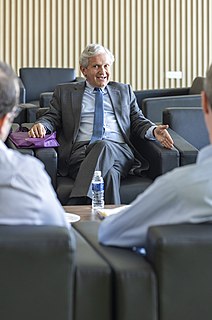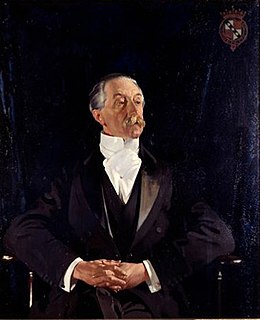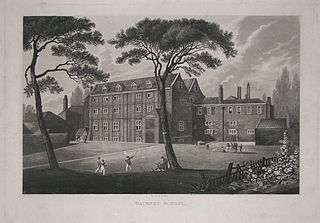The entries in this tabulation cover some 150 years in the 17th and 18th centuries, when the private residents of Covent Garden included many people of rank and note. They ranged from marquesses to barons, foreign ambassadors and members of parliament to physicians, surgeons, antiquaries, artists, authors and dramatists. Some of the later arrivals were auctioneers, such as Christopher Cock and Abraham Langford, who found rich sources for future sales amongst their neighbours.
Most of the entries are derived from The Piazza: Notable private residents in the Piazza, [1] which in turn is based on Sheppard's Survey of London: Volume 36, Covent Garden. [2] Other sources are noted where appropriate.
| Address | Dates | Residents |
|---|---|---|
| No. 43 King Street | 1637–43 | William Paget, Baron Paget of Beaudesert |
| No. 43 King Street | 1644 | John Trenchard |
| No. 43 King Street | 1645-7 | Sir Henry Vane the younger |
| No. 43 King Street | c.1647 | Sir Arthur Ingram |
| No. 43 King Street | c.1650-3 | Dr. William Rant |
| No. 43 King Street | 1655–61 | Sir Edward Hales, baronet |
| No. 43 King Street | 1662–5 | Sir Kenelm Digby |
| No. 43 King Street | 1666–80 | Denzil Holles, first Baron Holles of Ifield |
| No. 43 King Street | 1681–c.1688 | Nathaniel Crew, third Baron Crew of Stene |
| No. 43 King Street | c.1690–1727 | Hon. Edward Russell, first Earl of Orford |
| No. 1 Great Piazza | 1637–41 | Walter Montagu |
| No. 1 Great Piazza | 1644 | Sir William Waller |
| No. 1 Great Piazza | 1645– c.1647 | Sir Thomas Trenchard |
| No. 1 Great Piazza | c.1650–6 | John Paulet, fifth Marquis of Winchester |
| No. 1 Great Piazza | 1657–9 | Nathaniel Fiennes |
| No. 1 Great Piazza | 1660–1 | Charles Gerard, first Baron Gerard of Brandon, first Earl of Macclesfield |
| No. 1 Great Piazza | 1662–c.1703 | Sir Thomas Draper, knight |
| No. 1 Great Piazza | c.1703–17 | Lady Mary Draper |
| No. 1 Great Piazza | 1718–23 | Sir Harry Ashurst |
| No. 1 Great Piazza | 1749–1760 | William Hunter |
| No. 2 Great Piazza | 1639–41 | Sir John Harper |
| No. 2 Great Piazza | 1641–5 | Lady Mansell |
| No. 2 Great Piazza | c.1647–50 | Zouch Tate |
| No. 2 Great Piazza | 1650–65 | Mrs. [Catherine] Tate, wife of Zouch |
| No. 2 Great Piazza | 1666–8 | Sir Charles Cotterell, knight |
| No. 2 Great Piazza | 1676–85 | Sir Richard Temple, baronet |
| No. 2 Great Piazza | 1686–92 | Prosper Henricus Lankrink |
| No. 2 Great Piazza | 1707–8 | Lord 'Fitz-Williams' |
| No. 2 Great Piazza | 1708–11 | Lord Falconbridge |
| No. 2 Great Piazza | 1713 | Lord Powis |
| No. 2 Great Piazza | 1717–20 | Sir John Cotton |
| No. 2 Great Piazza | 1721 | Dr. Noel Broxholme |
| No. 3 Great Piazza | 1639–43 | John Mordaunt, first Earl of Peterborough |
| No. 3 Great Piazza | 1658–63 | Lady 'Holborne' |
| No. 3 Great Piazza | 1664–70 | William Broun(c)ker, second Viscount Brouncker |
| No. 3 Great Piazza | 1671–5 | Marchioness of Clanricarde |
| No. 3 Great Piazza | 1676 | Viscountess 'Muscree' |
| No. 3 Great Piazza | 1677–91 | Sir Thomas Orby [3] |
| No. 3 Great Piazza | 1692–1713 | John Closterman |
| No. 3 Great Piazza | 1714–c.1734 | Edward Gouge |
| No. 3 Great Piazza | c.1736–53 | Hamlet Winstanley |
| No. 4–5 Great Piazza | 1640–c.1641 | Sir Thomas Culpeper the elder |
| No. 4–5 Great Piazza | 1652–9 | Lady 'Calveley' |
| No. 4–5 Great Piazza | 1677–9 | Gregory King |
| No. 6–7 Great Piazza | 1638–40 | Sir William Alexander, first Earl of Stirling |
| No. 6-7 Great Piazza | 1640–4 | Sir Henry Wallop |
| No. 6-7 Great Piazza | 1645–c.1647 | Robert Wallop |
| No. 6-7 Great Piazza | 1653–4 | Sir Lionel Tollemache |
| No. 6-7 Great Piazza | 1655–7 | Edmund Dunch |
| No. 6-7 Great Piazza | 1658–60 | Viscount Burnell |
| No. 6-7 Great Piazza | 1663–90 | Hon. Edward Russell |
| No. 6-7 Great Piazza | 1691–c.1698 | Robert, Lord Russell |
| No. 8 Great Piazza | 1636–40 | Thomas Killigrew |
| No. 8 Great Piazza | 1640–1 | Philip Wharton, fourth Baron Wharton |
| No. 8 Great Piazza | c.1647 | Henry Mordaunt, second Earl of Peterborough |
| No. 8 Great Piazza | c.1651–7 | Sir David Watkins, knight |
| No. 8 Great Piazza | 1658–60 | Lady Watkins |
| No. 8 Great Piazza | 1661–2 | Thomas Killigrew |
| No. 8 Great Piazza | 1663–c. 1673 | Aubrey de Vere, twentieth Earl of Oxford |
| No. 8 Great Piazza | c.1675 | Resident envoy of the Republic of Venice |
| No. 8 Great Piazza | 1676–93 | Sir William Walter |
| No . 8 Great Piazza | 1694–c.1698 | Lady Knightley |
| No. 8 Great Piazza | c.1699 | Rt. Hon. Lord James Russell [4] |
| No. 8 Great Piazza | c.1702–1726 | Thomas Murray |
| No. 9–10 Great Piazza | 1640–3 | Robert Holborne |
| No. 9–10 Great Piazza | c.1647 | Colonel Thorp(e) |
| No. 9–10 Great Piazza | c.1651–71 | Lord Lucas |
| No. 9–10 Great Piazza | 1718–20 | Thomas Grey, second Earl of Stamford |
| No. 9–10 Great Piazza | 1720–30 | Hon. Edward Wortley Montagu |
| No. 9-10 Great Piazza | 1731-1748 | Christopher Cock, auctioneer |
| No. 9-10 Great Piazza | 1747- | Abraham Langford, auctioneer |
| No. 9-10 Great Piazza | 1790- | Henry Robins and brother John; and later, George Henry Robins, Henry's son; all auctioneers. [5] |
| No. 10–11 Great Piazza | 1637–9 | Sir Thomas Littleton, knight |
| No. 10–11 Great Piazza | 1639–43 | Sir John Winter |
| No. 10–11 Great Piazza | c.1651–80 | Sir Peter Lely |
| No. 10–11 Great Piazza | 1682–5 | Thomas Hawker |
| No. 10–11 Great Piazza | 1686–c.1694 | Roger North |
| No. 10–11 Great Piazza | c.1698 | Lady North |
| No. 10–11 Great Piazza | 1753–5 | Charles Macklin |
| No. 12 Great Piazza | 1637–c.1673 | Sir Edmund/Edward Pye |
| No. 12 Great Piazza | c.1675–93 | Lady Katherine Pye |
| No. 12 Great Piazza | 1694–1720 | Matthew Aylmer, Baron Aylmer |
| No. 12 Great Piazza | 1720–2 | Sir John Norris |
| No. 12 Great Piazza | 1722–34 | Sir James Thornhill |
| No. 12 Great Piazza | c.1736–41 | George Douglas, fourth Baron Mordington |
| No. 13–14 Great Piazza | 1635–43 | Sir Edward Sydenham |
| No. 13-14 Great Piazza | 1637–43 | Sir Charles Gawdy |
| No. 13-14 Great Piazza | 1638–43 | Lady Cooke |
| No. 13-14 Great Piazza | 1644–52 | Denzil Holles, first Baron Holles of Ifield |
| No. 13-14 Great Piazza | c.1645 | ? Sir William Constable |
| No. 13-14 Great Piazza | c.1645 | ? Edward Montague |
| No. 13-14 Great Piazza | 1656 | Mildmay Fane, second Earl of Westmorland |
| No. 13-14 Great Piazza | 1656–63 | Sir Edward Ford |
| No . 13-14 Great Piazza | 1664 | Charles Stuart, sixth Duke of Lennox, third Duke of Richmond |
| No . 13-14 Great Piazza | 1668 | Swedish ambassador |
| No. 13-14 Great Piazza | 1669–79 | Colonel John Strode [6] |
| No. 13-14 Great Piazza | 1669–c.1673 | Countess Dowager of Peterborough |
| No. 13-14 Great Piazza | c.1675–6 | Unspecified foreign diplomatic envoy |
| No. 13-14 Great Piazza | 1679–86 | Elizabeth, Lady Dacres, later Countess of Sheppey |
| No. 13-14 Great Piazza | 1686–9 | Edward Howard, fifth Earl of Carlisle |
| No. 13-14 Great Piazza | 1690–2 | Dutch ambassador |
| No. 13-14 Great Piazza | c.1702–14 | George Dodington |
| No. 13-14 Great Piazza | c.1720–25 | George Bubb Dodington, later first Baron Melcombe |
| No. 13-14 Great Piazza | 1726–32 | Dr. Douglas |
| No. 15 Great Piazza (back house) | 1743–60 | John Rich |
| No. 15 Great Piazza | 1761–7 | Priscilla Rich |
| No. 15 Great Piazza | 1769 | William Powell |
| No. 15 Great Piazza | 1769–1771 | Elizabeth Powell |
| No. 15 Great Piazza | 1772–4 | George Colman the elder |
| No. 16–17 Great Piazza | 1636–c.1641 | Sir Edmund Verney the elder |
| No. 16-17 Great Piazza | c.1643 | Sir Peter Ingram |
| No. 16-17 Great Piazza | 1644–7 | Countess of Peterborough |
| No. 16-17 Great Piazza | c.1651–7 | Sir Humphrey Tracy |
| No. 16-17 Great Piazza | 1659–63 | Sir Robert Bowles |
| No. 16-17 Great Piazza | 1664–6 | Mountjoy Blount, first Earl of Newport |
| No. 16-17 Great Piazza | 1679 | Lady Dacres |
| No. 16-17 Great Piazza | 1680 | Nathaniel Crew, third Baron Crew |
| No. 16-17 Great Piazza | 1682–c.1702 | Sir Godfrey Kneller, first baronet |
| No. 16-17 Great Piazza | 1727–c.1734 | Arthur Pond |
| No. 18–19 Great Piazza with No. 13 Russell Street | 1637–c.1641 | Lady Hobart ('Hubbert') |
| No. 18–19 Great Piazza with No. 13 Russell Street | 1652 | Doctor Denton |
| No. 18–19 Great Piazza with No. 13 Russell Street | 1679–1728 | James St. Amand [7] a |
| No. 1 Little Piazza | 1640–3 | Sir Thomas Hanmore |
| No. 1 Little Piazza | 1647 | Sir John Wittwrong [sic] |
| No. 2 Little Piazza | 1647 | Henry Wilmot, second Viscount Wilmot, later first Earl of Rochester |
| No. 2 Little Piazza | c.1651 | Earl of 'Kileare' |
| No. 2 Little Piazza | 1659 | Duke of Florence |
| No. 2 Little Piazza | 1660–4 | Earl of Meath |
| No. 2 Little Piazza | 1666–70 | Sir James Barkman Leyenberg |
| No. 2 Little Piazza | c.1674 | Sir Richard Temple, baronet |
| No. 3 Little Piazza | 1640– c.1647 | Sir William Uvedale |
| No. 3 Little Piazza | c.1651 | Sir William Plater |
| No. 3 Little Piazza | 1653 | Lord Savage |
| No. 3 Little Piazza | 1654 | Lady 'Savidge' |
| No. 3 Little Piazza | 1655 | Sir William Parkhurst [8] |
| No. 3 Little Piazza | 1656 | Countess Ancrum |
| No. 3 Little Piazza | 1657–61 | Jane, Lady Angier |
| No. 3 Little Piazza | 1663 | Murrough O'Brien, first Earl of Inchiquin |
| No. 3 Little Piazza | 1664–5 | Sir Edward Ford |
| No. 4 Little Piazza | 1691–2 | William De Ryck |
| No. 4 Little Piazza | c.1705–7 | Thomas Hawker |
| No. 4 Little Piazza | 1771–4 | John Abraham Fisher |
| No. 1 Tavistock Row | 1635–43 | Thomas Savile, first Viscount Savile, first Earl of Sussex |
| No. 1 Tavistock Row | 1644–c.1645 | Henry Grey, Earl of Kent |
| No. 1 Tavistock Row | 1660 | Richard Boyle, second Earl of Cork, later first Earl of Burlington, and Arthur Annesley, first Earl of Anglesey |
| No. 1 Tavistock Row | 1670–1 | Sir John Colladon [9] |
| No. 1 Tavistock Row | 1672 | Lady Cartwright |
| No. 1 Tavistock Row | c.1675–6 | Countess of Manchester |
| No. 1 Tavistock Row | 1677–84 | William Petre, fourth Baron Petre |
| No. 2–3 Tavistock Row | 1637–43 | Sir Peter Temple |
| No. 2–3 Tavistock Row | 1661 | Lady Cranburne |
| No. 2–3 Tavistock Row | 1662 | Lady Griffin |
| No. 37 Henrietta Street | c.1650–8 | Francis Clein |
| Henrietta Street | 1761 | Kitty Clive [10] |
| No. 1 King Street | 1639–c.1641 | Francis Russell esq. |
| No. 1 King Street | 1653–6 | Sir James Bridgman |
| King Street | 1690 | Lady Gorgess [10] |
| King Street | 1690 | Sir John Barber [10] |
| King Street | 1722 | Bishop of St David [10] |
| Maiden Lane | 1647 | Sir Cornelius Vermuyden [10] |









